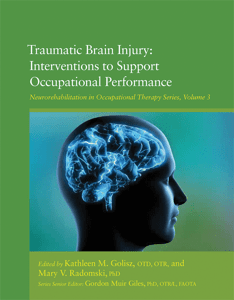Abstract
Traumatic brain injury (TBI) can occur at any age. Someone in the United States sustains a TBI approximately every 23 seconds and more than 25% of occupational therapists currently report working with clients with TBI. TBI’s interrelated physical, cognitive, and psychiatric and emotional effects can influence a client’s capacities, activities, relationships, and roles for months and years after the injury.
Section I of Traumatic Brain Injury (TBI): Interventions to Support Occupational Performance provides the core concepts and theoretical foundations that inform occupational therapy across the continuum of care for people with TBI. Section II provides detailed discussions of occupational therapy assessment and intervention at each phase of the recovery, rehabilitation, and community and social reintegration continuum. Features include Points to Ponder, a glossary, and a case study in which a client is followed through the various stages of recovery and rehabilitation, a glossary, and subject and citation indexes.
To purchase the bundled book and CE test (SPCC), click here.
To purchase the bundled book and CE test (SPCC), click here.
Details
Table of Contents
Traumatic Brain Injury (TBI): Interventions to Support Occupational Performance
-
Front Matter
11

- Section I. Core Concepts 132
- Section II. Traumatic Brain Injury Rehabilitation Across the Continuum of Recovery and Community Reintegration 133164
-
CHAPTER 4. The Case of Diane Archer
135166

-
CHAPTER 5. Rehabilitation of the Patient With a Disorder of Consciousness
139170

-
CHAPTER 6. The Acute, Inpatient, and Subacute Rehabilitation Phases of Recovery
175206

-
CHAPTER 7. Community Recovery and Participation
231262

-
CHAPTER 8. Special Considerations for Traumatic Brain Injury in Military Personnel
301332

-
CHAPTER 4. The Case of Diane Archer
135166
-
Glossary
319350

-
Indexes
345376

